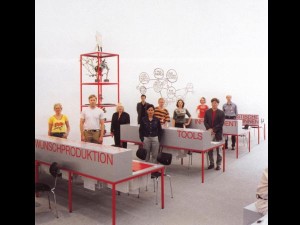Park Fiction organises Collective Productions of Desires for a park in Hamburg’s red light district, St.Pauli, since 1995. For more and detailed information in German as well as in English please turn to the website to the project’s website: park-fiction.net
A costly building was planned here originally, but the neighborhood stopped the development in 1997. After ten years of struggles the park was inaugurated in 2005. Today the neighborhood park has been realized. Designed by the residents, it is located with a view over the harbor, in a significant and beautiful place, that the city’s government wanted to sell to private investors.
Production of Desires in the Urban Field
The plans were stopped by a clever Network in the community. Instead of just protesting against the governments plans, this network organised a Parallel Planning Process in the community, creating Platforms of Exchange between people from different cultural fields: musicians, priests, a headmistress, a cook, café owners, bar-men, a psychologist, children, squatters, artists – Interventionist Residents.
INFOTAINEMENT
Instead of doing activism proper, Park Fiction made the struggle as well as the planning process work as a Platform of Exchange & Production. Lectures, talks, discussions, exhibitions and film-screenings employed the Local Knowledge, people started to make-each-other-more-clever.
TOOLS
Special tools were developed to make planning more accessible: the Plasticine Office, the Archive of Desires, questionnaires and maps, the Garden Library and the Action Kit (a portable planning studio with an unfoldable panorama view of the Elbe-River, for house visits), a telephone Hotline with answering machine for people who get inspired late at night.
Park Fiction organised the planning process like a game. Consequently, instead of handing out textual leaflets explaining how to access the process, Park Fiction gave out a Game board showing all the possibilities to become part of the project.
Installation developed by Margit Czenki, Christoph Schäfer for Park Fiction.
A few words about the installations of Multiplicity and Park Fiction by Jeebesh Bagchi from Sarai posted on [Aaj-ke-naam] list in 2002:
dear friends,
With the emergence of the exemplary idea of `shared footage` from neeraj, gurpal, setu and others, i would think the discussion on cultural production has gone up a bar. Thanks. Maybe all these images, testimonies etc can give rise to a shared space of interaction with people at large. Here i would like to share the formal strategies of two installation that i saw in Documenta 11 @ Kassel. These installations make one re-think the terms of engagement with a public through images, testimonies, text etc.
1) Muliplicity’s installation called `Solid Sea`(…)
2) Park Fiction’s installation on a struggle to save a working class playground from builders in Hamburg
This is again a collaborative installation by a group of people (architects, filmmakers, writers, lay people who joined together to keep a park in public use).Here the material were simple stuff that we all in india are familiar with:
– photographs, slides, and films (short and long)
– material that emerged during a long struggle (pamphlets, drawings, tool kits, writings, correspondence etc)
– books that are singnificant and often read and circulated.
– maps of the spaces and the dimensions of the struggle
– the letters to the bureacracy, petitions, etc.
The arrangement:
– nicely designed tables with provision for filing cabinet kind of file rollers and a covered edge that can house a small TV monitor.
They had about seven such long benches. The visitor comes and sits and moves through the files, sees slides being projected inside the covered part of the table, small Tv monitors running films, goes through maps, reads the books.
What was really amazing about this installation was it’s ability to get a small kid excited about it’s materials as much as any interested adult.
Further, it opens out the space of interpretation around the struggle and brings alive the process and complexity of the struggle. Again here you can hang around, move between things and come back to it.
I am sure practitioners here can innovate and bring in approaches and methods to create open and stimulating spaces of interactions, especially now that we have shared material.
For those interested, this link leads to a substantial review of Documenta:
http://www.villagevoice.com/issues/0227/levin.php
best
Jeebesh
